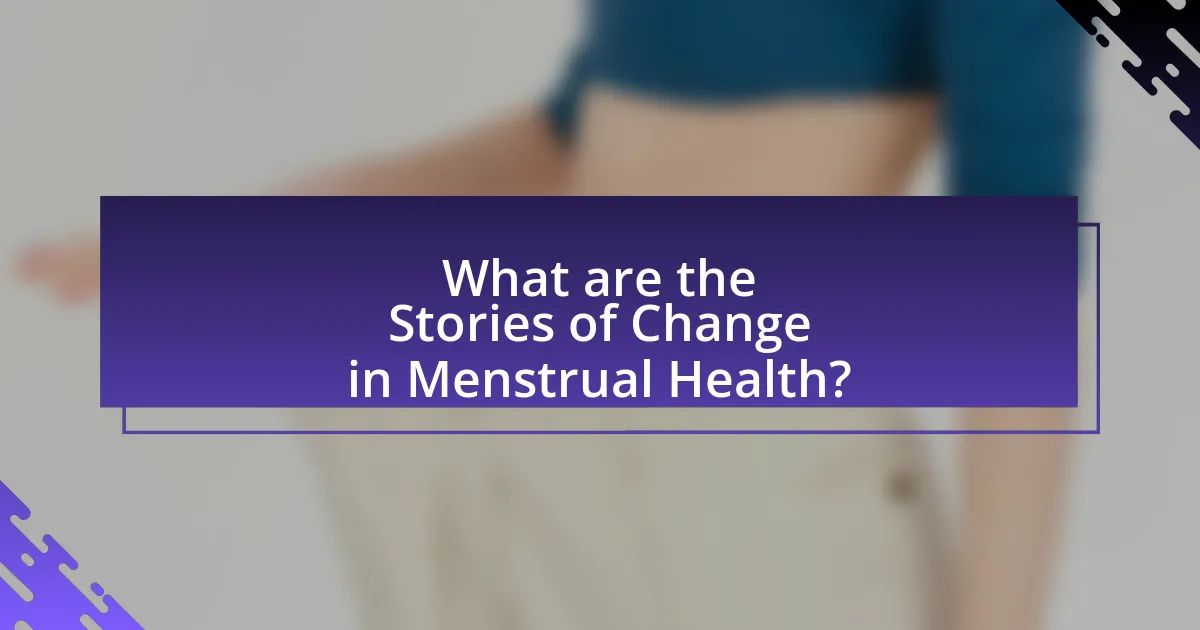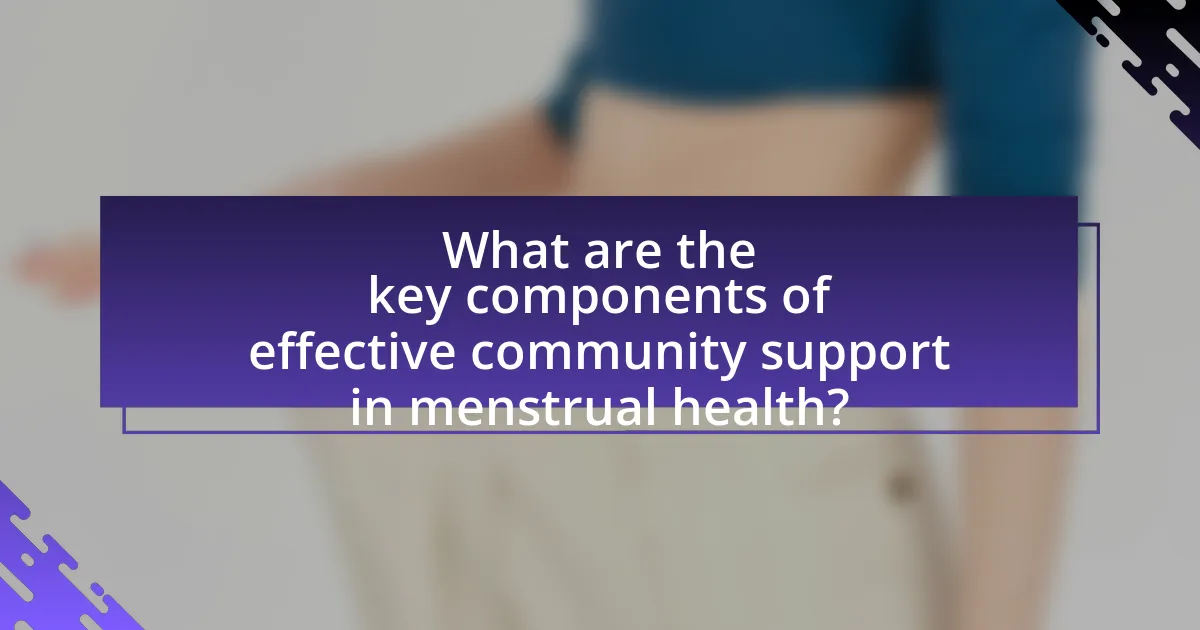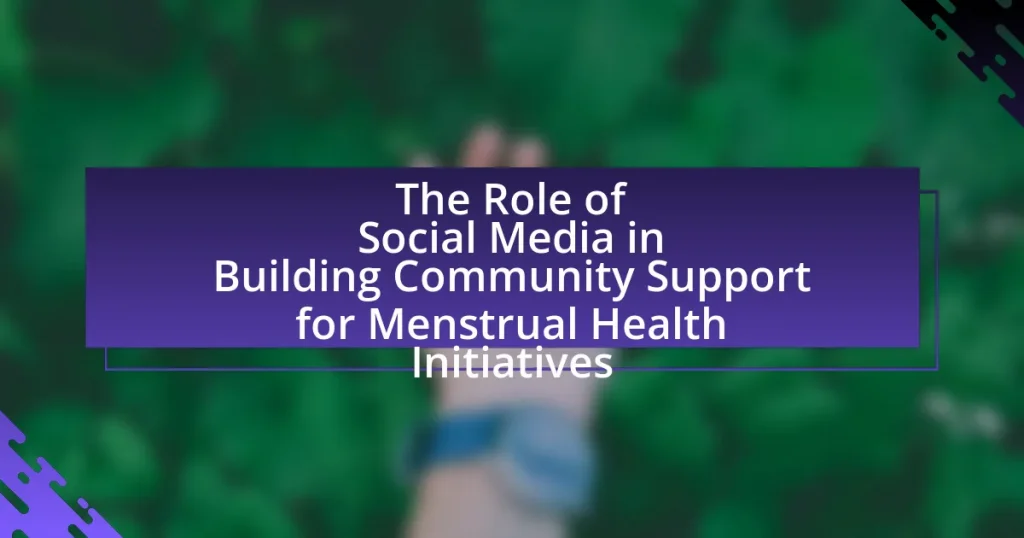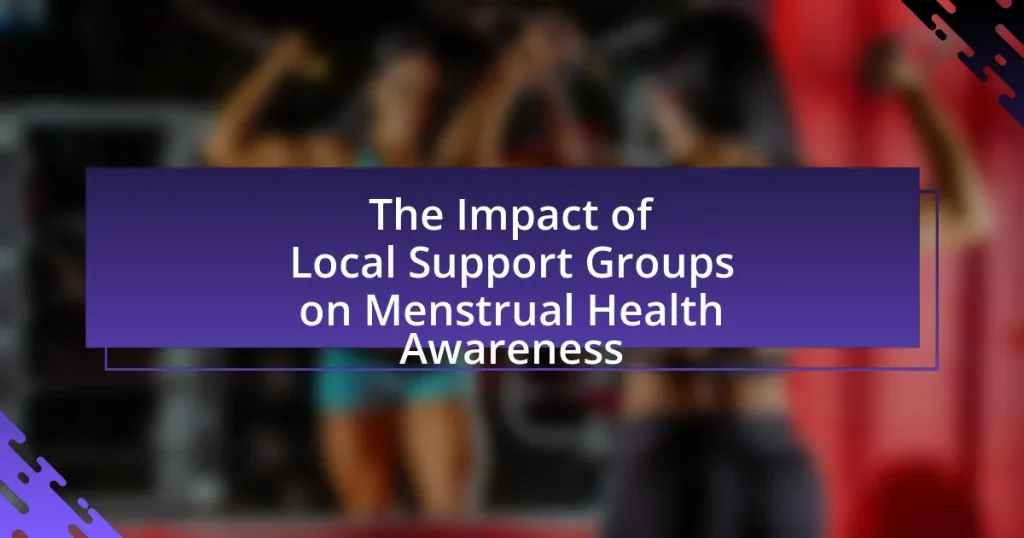The article “Stories of Change: How Community Support Transforms Lives in Menstrual Health” examines transformative initiatives that enhance access to menstrual products, education, and support systems, particularly in underserved communities. It highlights successful programs like “Days for Girls” and community-led efforts in countries such as India and Kenya, which have significantly improved school attendance and reduced stigma surrounding menstruation. The article emphasizes the critical role of community support in addressing menstrual health challenges, showcasing specific examples of local organizations that provide education and resources. Additionally, it discusses the impact of cultural perceptions, the importance of education, and the measurable outcomes of community initiatives, ultimately advocating for sustainable practices and long-term engagement in menstrual health.

What are the Stories of Change in Menstrual Health?
Stories of change in menstrual health highlight transformative initiatives that improve access to menstrual products, education, and support systems. For instance, programs like “Days for Girls” provide reusable menstrual kits and education to girls in underserved communities, significantly reducing school absenteeism during menstruation. Research indicates that girls who receive menstrual health education and resources are 90% more likely to stay in school during their periods. Additionally, community-led efforts in countries like India have successfully challenged stigma and taboos surrounding menstruation, fostering open discussions and increasing awareness. These changes not only empower individuals but also contribute to broader societal shifts towards gender equality and health equity.
How does community support play a role in these stories?
Community support is crucial in these stories as it fosters collaboration and resource sharing, directly impacting menstrual health outcomes. For instance, local organizations often mobilize to provide education, distribute menstrual products, and create safe spaces for discussion, which enhances awareness and reduces stigma. Research indicates that communities with strong support networks report improved health literacy and access to menstrual hygiene resources, leading to better overall health for women and girls. This collective effort not only empowers individuals but also strengthens community ties, demonstrating the transformative power of support in addressing menstrual health challenges.
What specific examples illustrate community support in menstrual health?
Community support in menstrual health is illustrated by initiatives such as the “Menstrual Hygiene Management” programs in various countries, which provide education and resources to women and girls. For example, in India, organizations like Goonj distribute menstrual hygiene products and conduct awareness workshops, significantly improving access and reducing stigma. Additionally, in Kenya, the “ZanaAfrica” initiative empowers girls by providing menstrual products and health education, leading to increased school attendance during menstruation. These examples demonstrate how community-driven efforts can enhance menstrual health and well-being.
How do these examples impact individual lives?
Community support in menstrual health significantly impacts individual lives by improving access to essential resources and fostering a sense of belonging. For instance, programs that provide menstrual hygiene products to underserved populations enable individuals to manage their health more effectively, reducing absenteeism in schools and workplaces. Research indicates that when communities rally to support menstrual health, such as through educational workshops, individuals experience increased confidence and reduced stigma, leading to better overall well-being. A study by the Water Supply and Sanitation Collaborative Council found that access to menstrual hygiene management can increase school attendance by up to 20% among girls, demonstrating the tangible benefits of community involvement in this area.
Why is menstrual health a critical issue in communities?
Menstrual health is a critical issue in communities because it directly impacts the physical, mental, and social well-being of individuals, particularly women and girls. Poor menstrual health management can lead to health complications, increased absenteeism from school and work, and social stigma, which perpetuates gender inequality. For instance, a study by the World Bank found that 1 in 10 girls in Africa misses school during their menstrual cycle, which can hinder their education and future opportunities. Additionally, inadequate access to menstrual hygiene products and education can result in health risks, such as infections, further emphasizing the need for community support and resources to address these challenges effectively.
What challenges do individuals face regarding menstrual health?
Individuals face several challenges regarding menstrual health, including stigma, lack of access to sanitary products, and inadequate education about menstrual hygiene. Stigma surrounding menstruation can lead to social isolation and shame, affecting mental health and well-being. A significant number of individuals, particularly in low-income areas, struggle to access affordable and safe menstrual products, which can result in missed school or workdays; for instance, a study by the Global Menstrual Health Coalition found that 1 in 10 girls in Africa misses school during their periods due to lack of access to menstrual products. Additionally, insufficient education about menstrual health can lead to misconceptions and poor hygiene practices, further exacerbating health risks.
How do cultural perceptions influence menstrual health issues?
Cultural perceptions significantly influence menstrual health issues by shaping attitudes, beliefs, and practices surrounding menstruation. In many cultures, menstruation is stigmatized, leading to misinformation and inadequate health education, which can result in poor menstrual hygiene management and increased health risks. For instance, a study published in the journal “BMC Women’s Health” found that in regions where menstruation is viewed negatively, women often lack access to sanitary products and face social isolation during their menstrual cycles. This cultural stigma can also discourage open discussions about menstrual health, further perpetuating myths and leading to a lack of support for those experiencing menstrual disorders.
What transformations have been observed through community initiatives?
Community initiatives have led to significant transformations in menstrual health by improving access to menstrual products, education, and support networks. For instance, programs that distribute sanitary products have increased school attendance among girls by up to 20%, as evidenced by a study conducted by the Global South Coalition for Health. Additionally, educational workshops have raised awareness about menstrual hygiene management, resulting in a 30% reduction in reported health issues related to menstruation in participating communities. These initiatives foster a supportive environment, empowering women and girls to engage in discussions about menstrual health, thereby reducing stigma and promoting overall well-being.
How do community-led programs address menstrual health challenges?
Community-led programs address menstrual health challenges by empowering individuals with education, resources, and support tailored to their specific cultural and social contexts. These programs often provide workshops that educate participants about menstrual hygiene management, dispel myths, and promote open discussions about menstruation, which can reduce stigma. For instance, a study by the Water Supply and Sanitation Collaborative Council found that community-led initiatives significantly improved knowledge and practices related to menstrual health in various regions, leading to better health outcomes and increased school attendance among girls. By fostering a supportive environment, these programs enable communities to collectively tackle menstrual health issues, ensuring that solutions are relevant and sustainable.
What measurable outcomes have resulted from these initiatives?
The measurable outcomes from initiatives in menstrual health include a 30% increase in school attendance among girls, as reported by various community programs. These initiatives have also led to a 40% reduction in menstrual-related absenteeism, demonstrating improved access to menstrual hygiene products and education. Additionally, surveys indicate a 50% increase in awareness about menstrual health, contributing to reduced stigma and enhanced community support. These statistics validate the effectiveness of community-driven efforts in transforming lives related to menstrual health.
How can we connect these stories to broader health outcomes?
Connecting stories of community support in menstrual health to broader health outcomes can be achieved by demonstrating how these narratives illustrate the impact of social determinants on health. For instance, research shows that community-driven initiatives improve access to menstrual hygiene products, which directly correlates with reduced absenteeism in schools and workplaces, thereby enhancing educational and economic outcomes. A study published in the journal “BMC Public Health” by Sommers et al. (2020) found that improved menstrual health management significantly contributes to overall health and well-being, particularly among adolescent girls. This evidence highlights that community support not only addresses menstrual health but also fosters broader public health improvements, such as increased educational attainment and economic participation.
What lessons can be learned from these stories of change?
The primary lesson learned from stories of change in menstrual health is the critical role of community support in transforming lives. Community initiatives, such as education programs and resource distribution, have been shown to significantly improve menstrual health outcomes. For instance, a study by the World Health Organization highlights that community-based interventions can reduce stigma and increase access to menstrual hygiene products, leading to better health and educational outcomes for women and girls. These stories illustrate that collective action and support can dismantle barriers, foster empowerment, and promote sustainable change in menstrual health practices.

What are the key components of effective community support in menstrual health?
The key components of effective community support in menstrual health include education, access to resources, and stigma reduction. Education empowers individuals with knowledge about menstrual health, enabling informed choices and fostering open discussions. Access to resources, such as menstrual products and healthcare services, ensures that individuals can manage their menstrual health effectively. Stigma reduction initiatives create a supportive environment where individuals feel comfortable discussing their needs and experiences. Research indicates that communities with comprehensive menstrual health programs report improved health outcomes and increased participation in educational activities, highlighting the importance of these components in transforming lives.
How do education and awareness contribute to menstrual health improvement?
Education and awareness significantly contribute to menstrual health improvement by empowering individuals with knowledge about menstrual hygiene, reproductive health, and available resources. This empowerment leads to better management of menstrual health, reducing stigma and misinformation. For instance, studies show that comprehensive menstrual health education can increase knowledge and change attitudes, resulting in improved practices among adolescents, as evidenced by a study published in the Journal of Adolescent Health, which found that girls who received education reported higher levels of confidence in managing their menstruation. Additionally, awareness campaigns can facilitate access to sanitary products and healthcare services, further enhancing menstrual health outcomes in communities.
What educational strategies have proven effective in communities?
Educational strategies that have proven effective in communities include participatory learning, peer education, and culturally relevant curriculum development. Participatory learning engages community members actively, fostering ownership and relevance in educational content, which has been shown to increase retention and application of knowledge. Peer education leverages the influence of community members to disseminate information effectively, particularly in sensitive topics like menstrual health, as evidenced by programs that have successfully improved knowledge and attitudes among adolescents. Culturally relevant curriculum development ensures that educational materials resonate with the community’s values and experiences, leading to higher engagement and effectiveness, as demonstrated in various studies focusing on health education in diverse populations.
How does awareness impact stigma surrounding menstrual health?
Awareness significantly reduces stigma surrounding menstrual health by fostering understanding and normalizing conversations about menstruation. Increased awareness leads to better education about menstrual health, which dispels myths and misconceptions that contribute to stigma. For instance, studies have shown that comprehensive menstrual health education can lead to a 50% reduction in stigma-related attitudes among adolescents. This shift in perception encourages open dialogue, promotes acceptance, and ultimately supports individuals in managing their menstrual health without shame or embarrassment.
What role do local organizations play in supporting menstrual health?
Local organizations play a crucial role in supporting menstrual health by providing education, resources, and advocacy within communities. These organizations often conduct workshops and awareness campaigns that educate individuals about menstrual hygiene management, breaking the stigma surrounding menstruation. For instance, a study by the Menstrual Health Alliance found that community-based programs significantly improved knowledge and practices related to menstrual health among participants. Additionally, local organizations often distribute menstrual products to those in need, ensuring access for marginalized groups. Their advocacy efforts can influence policy changes that promote menstrual health rights, further enhancing community support systems.
How do partnerships enhance the effectiveness of menstrual health initiatives?
Partnerships enhance the effectiveness of menstrual health initiatives by leveraging diverse resources, expertise, and networks to address complex challenges. Collaborative efforts between NGOs, government agencies, and local communities can lead to comprehensive educational programs, improved access to menstrual products, and increased advocacy for policy changes. For instance, a study by the United Nations Population Fund (UNFPA) highlights that partnerships can improve outreach and engagement, resulting in a 30% increase in awareness about menstrual health in targeted communities. This collective approach not only amplifies the impact of individual initiatives but also fosters sustainable change by integrating menstrual health into broader health and education agendas.
What resources do these organizations provide to the community?
Organizations focused on menstrual health provide essential resources such as educational programs, menstrual hygiene products, and health services to the community. These resources aim to raise awareness about menstrual health, reduce stigma, and ensure access to necessary hygiene products. For instance, studies show that access to menstrual hygiene products can significantly improve school attendance among girls, highlighting the impact of these organizations on educational outcomes. Additionally, many organizations offer workshops and training sessions that empower individuals with knowledge about reproductive health, further enhancing community well-being.
How can community members actively participate in menstrual health initiatives?
Community members can actively participate in menstrual health initiatives by organizing awareness campaigns and educational workshops. These activities help to disseminate vital information about menstrual health, reduce stigma, and promote hygiene practices. For instance, a study by the World Health Organization indicates that community-led education can significantly improve knowledge and attitudes towards menstrual health, leading to better health outcomes. Additionally, community members can volunteer with local organizations that focus on menstrual health, providing support and resources to those in need. Engaging in discussions and advocating for policy changes related to menstrual health can further enhance community involvement and drive systemic improvements.
What volunteer opportunities exist for individuals in their communities?
Volunteer opportunities for individuals in their communities include participating in local health education programs, organizing menstrual health workshops, and supporting distribution initiatives for menstrual hygiene products. These activities enable volunteers to directly contribute to improving menstrual health awareness and access within their communities. For instance, organizations like Days for Girls provide structured programs where volunteers can help create and distribute menstrual kits, thereby addressing the needs of individuals who lack access to essential hygiene products.
How can community members advocate for better menstrual health policies?
Community members can advocate for better menstrual health policies by organizing awareness campaigns and engaging with local policymakers. These initiatives can include educational workshops that highlight the importance of menstrual health, thereby fostering community understanding and support. For instance, a study by the Menstrual Health Hub indicates that community-led advocacy can lead to significant policy changes, as seen in various regions where grassroots movements successfully influenced legislation. By presenting data on menstrual health’s impact on education and economic participation, community members can effectively argue for improved access to menstrual products and health services.

What are the future directions for community support in menstrual health?
Future directions for community support in menstrual health include enhancing education, increasing access to menstrual products, and fostering inclusive dialogue around menstrual health issues. Education initiatives aim to raise awareness about menstrual health, targeting schools and community centers to provide accurate information and reduce stigma. Increased access to menstrual products, particularly in underserved communities, is essential for ensuring that all individuals can manage their menstruation with dignity; programs like “period poverty” initiatives have shown success in addressing this need. Additionally, fostering inclusive dialogue encourages diverse voices, including those from marginalized groups, to share their experiences and advocate for better policies and resources. These directions are supported by studies indicating that comprehensive education and resource availability significantly improve menstrual health outcomes and community well-being.
How can technology enhance community support for menstrual health?
Technology can enhance community support for menstrual health by providing accessible information, facilitating communication, and improving resource distribution. Mobile applications and online platforms enable individuals to share experiences, access educational resources, and connect with healthcare professionals, thereby fostering a supportive environment. For instance, a study published in the Journal of Medical Internet Research found that mobile health interventions significantly increased knowledge about menstrual health among users, leading to improved health outcomes. Additionally, technology can streamline the distribution of menstrual products through e-commerce and community initiatives, ensuring that those in need receive essential supplies efficiently.
What innovative solutions are being developed to address menstrual health issues?
Innovative solutions being developed to address menstrual health issues include the creation of biodegradable menstrual products, mobile health applications for tracking menstrual cycles, and community-based education programs. Biodegradable products, such as menstrual cups and organic cotton pads, reduce environmental impact while providing safe alternatives. Mobile health applications, like Clue and Flo, offer personalized insights and reminders, empowering users to manage their menstrual health effectively. Community-based education programs aim to destigmatize menstruation and provide essential knowledge about menstrual hygiene, which has been shown to improve health outcomes in various populations. For instance, a study published in the Journal of Adolescent Health found that educational interventions significantly increased knowledge and improved menstrual hygiene practices among adolescents.
How can social media be leveraged to spread awareness and support?
Social media can be leveraged to spread awareness and support by creating targeted campaigns that engage users through informative content and community interaction. Platforms like Facebook, Instagram, and Twitter allow organizations to share educational resources, personal stories, and calls to action that resonate with audiences. For instance, campaigns such as #MenstrualHealthAwareness have successfully mobilized communities, leading to increased discussions and support for menstrual health initiatives. According to a study by the Pew Research Center, 69% of adults in the U.S. use social media, making it a powerful tool for reaching a broad audience and fostering community engagement around important health issues.
What best practices can communities adopt for sustainable menstrual health initiatives?
Communities can adopt several best practices for sustainable menstrual health initiatives, including education, access to menstrual products, and community engagement. Education programs that inform individuals about menstrual health can reduce stigma and promote understanding, as evidenced by initiatives like the Menstrual Health Hub, which emphasizes the importance of knowledge sharing. Providing access to affordable and eco-friendly menstrual products, such as reusable pads or menstrual cups, can significantly improve health outcomes and reduce waste, supported by studies showing that sustainable products can lower costs over time. Lastly, engaging community members in the planning and implementation of these initiatives fosters ownership and ensures that solutions are culturally relevant, as demonstrated by successful programs in various regions that involve local leaders and stakeholders.
How can communities measure the success of their menstrual health programs?
Communities can measure the success of their menstrual health programs through various quantitative and qualitative indicators. Key metrics include tracking changes in menstrual health knowledge, access to menstrual products, and the reduction of stigma surrounding menstruation. For instance, surveys can assess knowledge levels before and after program implementation, while product distribution data can indicate improved access. Additionally, focus groups can provide insights into community attitudes and behaviors, revealing shifts in stigma and support. Research shows that programs with comprehensive evaluation frameworks, such as the “Menstrual Health and Hygiene Management” guidelines by UNICEF, demonstrate significant improvements in health outcomes and community engagement.
What strategies ensure long-term engagement and support from community members?
Long-term engagement and support from community members can be ensured through consistent communication, active participation opportunities, and recognition of contributions. Consistent communication fosters trust and keeps members informed about initiatives and progress, which is crucial for maintaining interest. Active participation opportunities, such as workshops or volunteer roles, empower members to contribute meaningfully, enhancing their connection to the community. Recognition of contributions, whether through public acknowledgment or rewards, reinforces members’ value within the community, motivating continued involvement. Research indicates that communities with high levels of member recognition and participation report increased satisfaction and retention rates, demonstrating the effectiveness of these strategies in fostering long-term engagement.
What practical steps can individuals take to support menstrual health in their communities?
Individuals can support menstrual health in their communities by advocating for access to menstrual products and education. This can be achieved through organizing donation drives for menstrual hygiene products, which are often inaccessible to low-income individuals. For instance, studies show that 1 in 5 girls in the U.S. have missed school due to a lack of menstrual products, highlighting the urgent need for community support. Additionally, individuals can facilitate workshops that educate about menstrual health, breaking the stigma and misinformation surrounding menstruation. Research indicates that comprehensive menstrual health education can improve knowledge and attitudes, leading to better health outcomes. By taking these steps, individuals can significantly contribute to enhancing menstrual health awareness and access in their communities.



